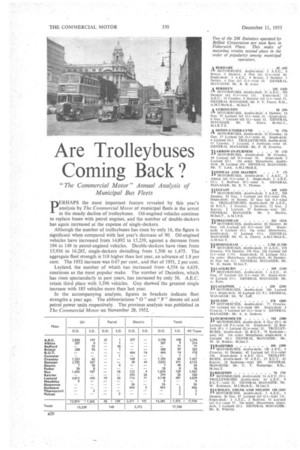Are Trolleybuses Coming Back ?
Page 54

If you've noticed an error in this article please click here to report it so we can fix it.
"The Commercial Motor" Annual Analysis of Municipal Bus Fleets
pERHAPS the most important feature revealed by this year's analysis by The Commercial Motor of municipal fleets is the arrest in the steady decline of trolleybuses. Oil-engined vehicles continue to replace buses with petrol engines, and the number of double-deckers has again increased at the expense of single-deckers.
Although the number of trofieybuses has risen by only 16, the figure is significant when compared with last year's decrease of 90. Oil-engined vehicles have increased from 14,892 to 15,239, against a decrease from 194 to 149 in petrol-engined vehicles. Double-deckers have risen from 15,936 to 16,285, single-deckers dwindling from 1,506 to 1,475. The aggregate fleet strength is 318 higher than last year, an advance of 1.8 per cent. The 1952 increase was 0.67 per cent., and that of 1951, 2 per cent.
Leyland, the number of which has increased from 4,554 to 4,639, continues as the most popular make. The number of Daimlers, which has risen spectacularly in past years, has increased by only 56. A.E.C. retain third place with 3,396 vehicles. Guy showed the greatest single increase with 185 vehicles more than last year.
In the accompanying analysis, figures in brackets indicate fleet strengths a year ago. The abbreviations "0 " and " P " denote oil and petrol power units respectively. The previous analysis was published in The Commercial Motor on November 28, 1952. ,




















































































































